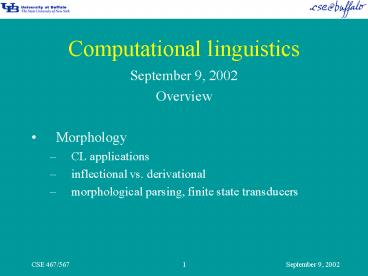Computational linguistics - PowerPoint PPT Presentation
1 / 10
Title:
Computational linguistics
Description:
Concatenative morphology combines morphemes by concatentation (prefixes and ... consonant-vowel (CV) template: CVCCVC (causative) vocalization: ui (perfect passive) ... – PowerPoint PPT presentation
Number of Views:33
Avg rating:3.0/5.0
Title: Computational linguistics
1
Computational linguistics
- September 9, 2002
- Overview
- Morphology
- CL applications
- inflectional vs. derivational
- morphological parsing, finite state transducers
2
Applications
- lexicons
- stemming
- generating correct surface word forms
3
Terminology
- Morpheme smallest meaning-bearing unit
- Free independent words
- Bound affix
- prefix (un-)
- suffix (-ing)
- circumfix (German ge-t sagen ? gesagt)
- infix (Bontoc Igorot -in- kayu ? kinayu)
- example from Linguistics, second edition, by
Akmajian, Demers and Harnish, page 59
4
Concatenative vs. nonconcatenative
- Concatenative morphology combines morphemes by
concatentation (prefixes and suffixes demonstrate
this) - Non-concatentative morphology combines in a
non-concatenative manner - circumfixes and infixes
- templatic morphology
5
Templatic morphology
- Semitic languages (Arabic, Hebrew)
- stem (root), e.g. ktb (write)
- consonant-vowel (CV) template CVCCVC (causative)
- vocalization ui (perfect passive)
- Combination consonants in stem map onto Cs in
template, vowels in vocalization map onto Vs to
yield surface form kuttib
6
Try it out!
- http//www.xrce.xerox.com/competencies/content-ana
lysis/arabic/input/keyboard_input.html
7
Morphology
- Inflectional morphology
- usually does not change grammatical category
- Ex cat(N) /plural/ cats(N)
- Derivational morphology
- typically changes grammatical category
- Ex program(N) able programmable(ADJ)
8
Parsing
- refers to the recovery of structure from analysis
of input - often refers to the processing of sentences
- can also refer to the processing of words
- Stemming refers to the recovery of a word stem
given a surface form of the word - uncharacteristically un character istic
ally
9
Lexicons
- One approach list all words
- difficult in English because some morphology is
productive - (table adapted from page 62 of text)
10
Options
- Not only do some affixes attach to large numbers
of stems, - they also attach to new words in the language
- spam, spams, spamming, spammed, spammer
- Idea encode morphological rules to generate all
forms of words from a minimal set of word stems. - Figure 3.4, 3.5
- Exercise 3.1, 3.2

